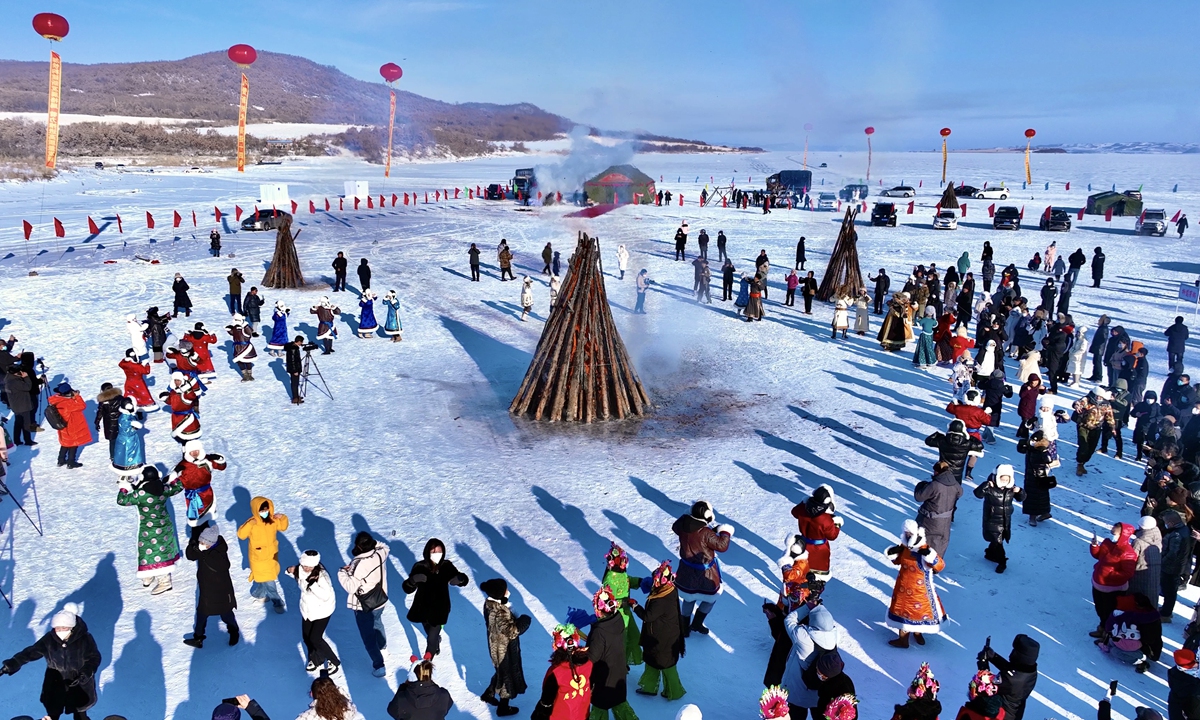ARTS / CULTURE & LEISURE
Daur people keep thousand-year-old traditions through festival celebrations
Long-lasting inheritance

People celebrate Hulun Buir's first ice and snow sports tourism season in North China's Inner Mongolia Autonomous Region in January. Photo: Courtesy of the culture and tourism bureau of Morin Dawa Daur Autonomous Banner
Editor’s Note:
China, a united multi-ethnic country, has 56 ethnic groups. Each of the ethnic groups has its own distinctive history and tradition, contributing to the rich Chinese culture. The Global Times is to publish a series of articles focusing on the folk traditions of the ethnic groups including costumes, festivals and customs to show their unique beauty.
On the 16th day of the first month of the Chinese lunar calendar, 40-year-old Yire got up very early. She quickly and quietly crept to the room where the children were still sleeping on the kang (traditional bed) and smeared black ash she had scraped from the bottom of the pot on their faces and wished them a safe and healthy year. The children and grandchildren later also smeared the ashes on their elders' faces. During this "smearing festival" the person with the most ash on their face is believed to be the luckiest. The festival is considered a city-level intangible cultural heritage, among the Daur people, one of the many Chinese ethic minority groups.
"The smearing is no longer limited to the elder generations, everyone can smear each other to ward off evil spirits and pray for good blessings," Yire told the Global Times, expressing her pride to be a Daur person.
Maintaining the heritage
In order to inherit and spread the traditional Daur culture to more people, Yire opened public accounts on Chinese social media platforms and posted articles and videos about this unique minority group.
Her recent videos about the ice-piercing for fishing in Hulun Buir's first ice and snow sports tourism season, in North China's Inner Mongolia Autonomous Region, have captured the attention of many viewers.
On the day of the event, the Daur people sang and danced around a burning bonfire. They hold a traditional thousand-year-old fishing competition, and cooked the fish just out of the water on the spot. Everyone seems to be fully emerged into the boisterous festivity.
Meng Liying, director general of the culture and tourism bureau of Morin Dawa Daur Autonomous Banner in Hulun Buir, told the Global Times that the ice fishing originated from their ancestors, the Khitan or Qidan people, which has been proved by the historical record - people "chiseling the ice to get fish" in winter. The place where the Daur people lived was surrounded by rivers and mountains, contributing to a rich fish resources. Thanks to the fruitful natural environment and resources, the Daur people were able to keep the tradition of ice-piercing until today.
Additionally, the local authority also launched traditional food appreciation events, a festival themed New Year's goods, ice and snow sports competitions, immersive intangible cultural heritage experiences and a winter carnival.
According to Meng, the events attracted nearly 2,000 tourists from Northeast China's Heilongjiang Province and surrounding areas, and nearly 20,000 people watched the live broadcast of the Intangible Cultural Heritage Festival.
The Morin Dawa Daur Autonomous Banner has 38 intangible cultural heritage projects, of which four are national intangible cultural heritage projects.
Meng said that traditional culture is an important part of the activities. People can experience the charm of traditional culture at the event, and become more aware of cultural protection and inheritance. Besides, the various activities are also an effective display of traditional culture. The inheritors of traditional culture can better understand people's needs, broaden their thinking and innovate methods of cultural inheritance.
Ancient ancestors
The Daur people are a minority group in China, with only 132,299 members, according to the census carried out in 2021. The DNA analyses have proven that the Daurs are descendants of the ancient Khitan people, a historical a nomadic people originating in eastern Inner Mongolia.
They first appeared in records of the Northern Wei Dynasty (386-534), where they are described as descending from the Xianbei people. The Khitan people formed the Liao Dynasty (907-1125), a match for their rivals, the Song Dynasty (907-1279), and ruled parts of Mongolia and northern China. After the fall of the Liao Dynasty, many Khitans migrated westward and established the Western Liao Dynasty. They were in turn absorbed by the local Turkic and Iranian populations and left no trace. They have been classified by Chinese historians as one of the Eastern proto-Mongolic ethnic groups.
Currently, the Daur people mainly live in Hulun Buir, Inner Mongolia Autonomous Region and Qiqihar, Heilongjiang Province, and still keep some traditions left by their ancestors.
Cultural promoter
Yire, who considers herself as a cultural promoter, told the Global Times that though the content she posts belongs to a niche and is not likely to trend on social media, she takes it as a responsibility to promote her ethnic group's culture. She said she feels very motivated, and even a little moved when reading some of the comments viewers left under her videos. Comments like "You deserve a thumb-up as you are doing something that is very meaningful."
"Daur culture, as one of the minority cultures, is an indispensable part of Chinese culture. I would like to be the cultural promoter for my people and will continue doing this as long as I can," said Yire.

